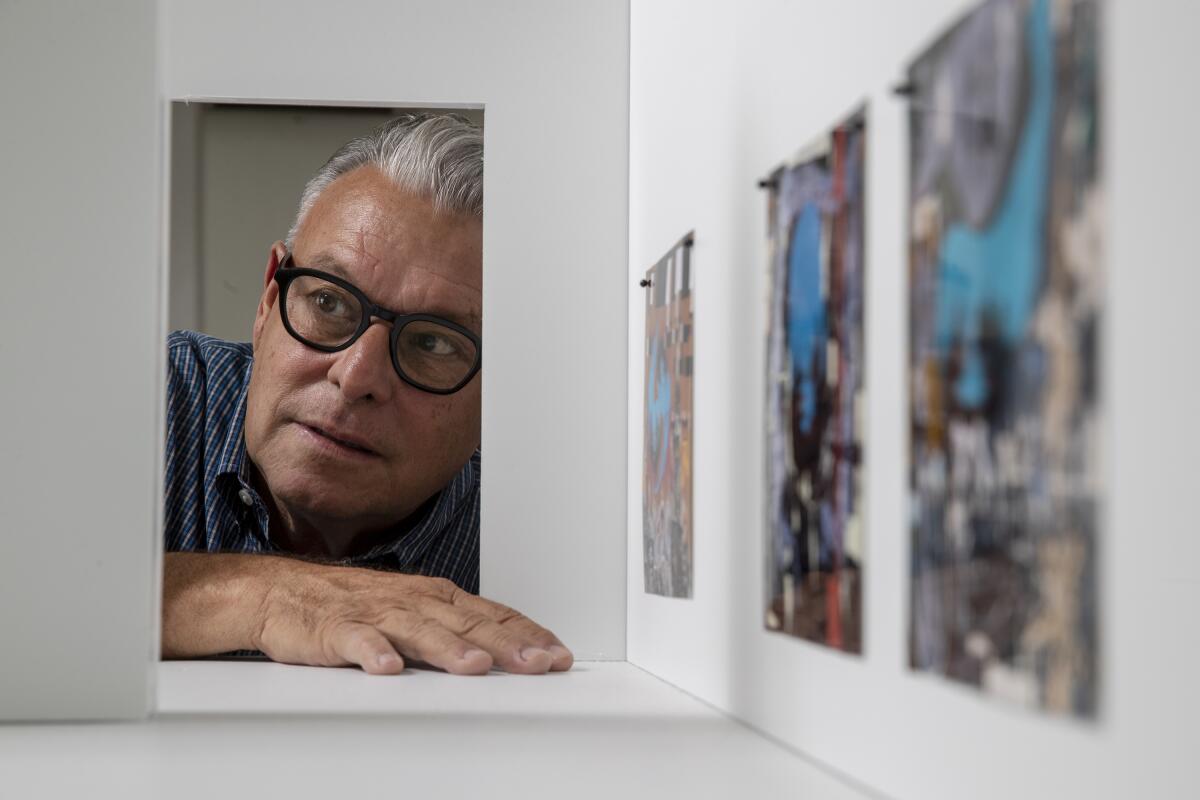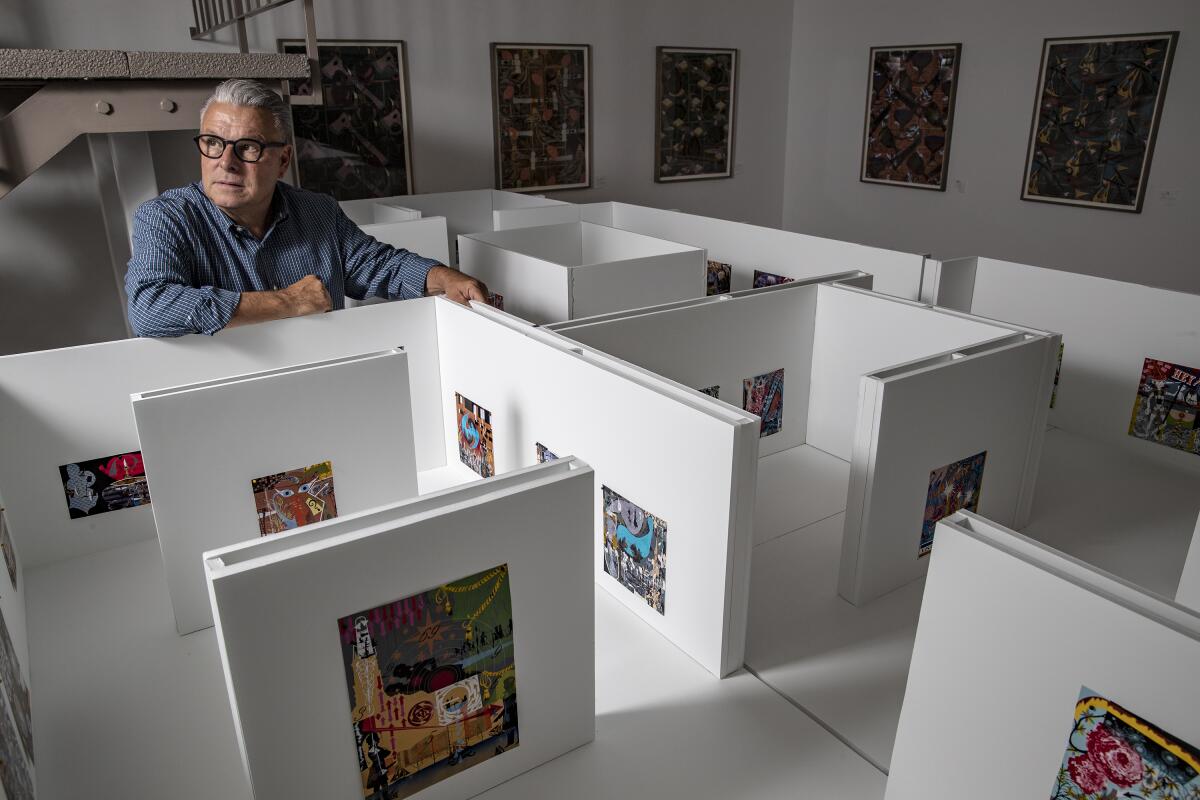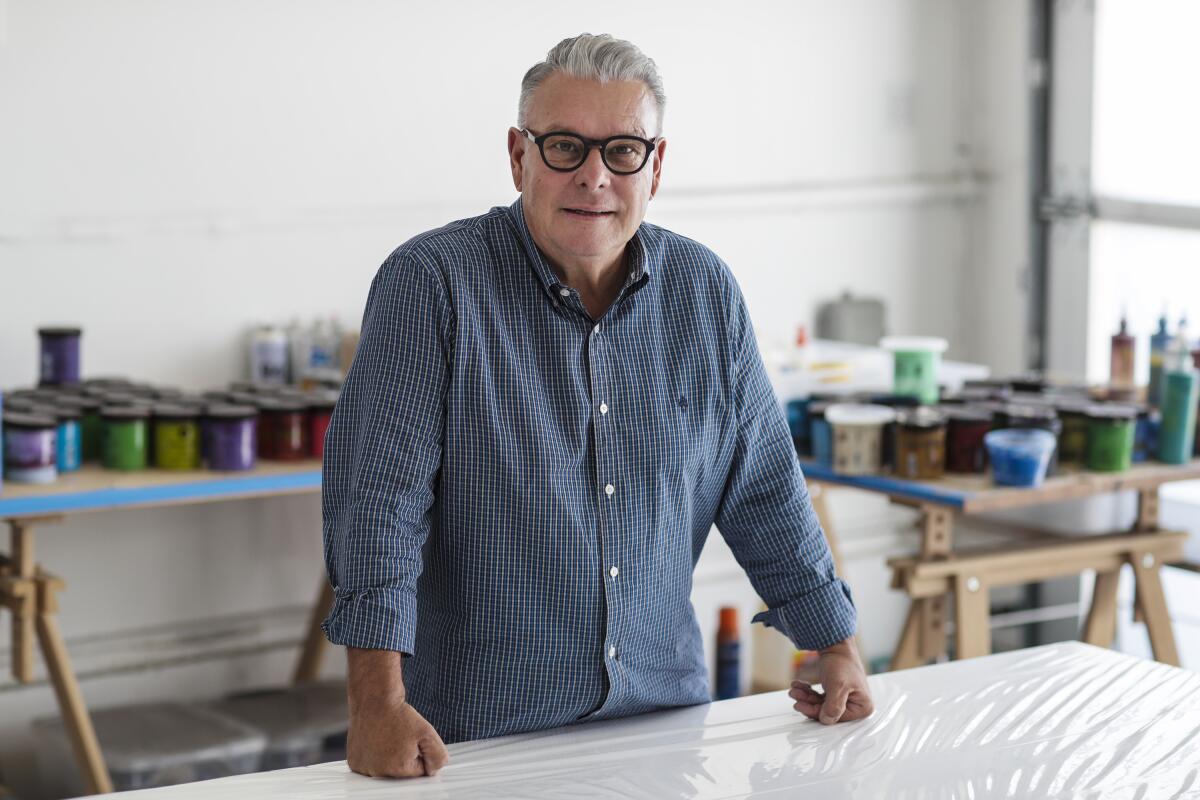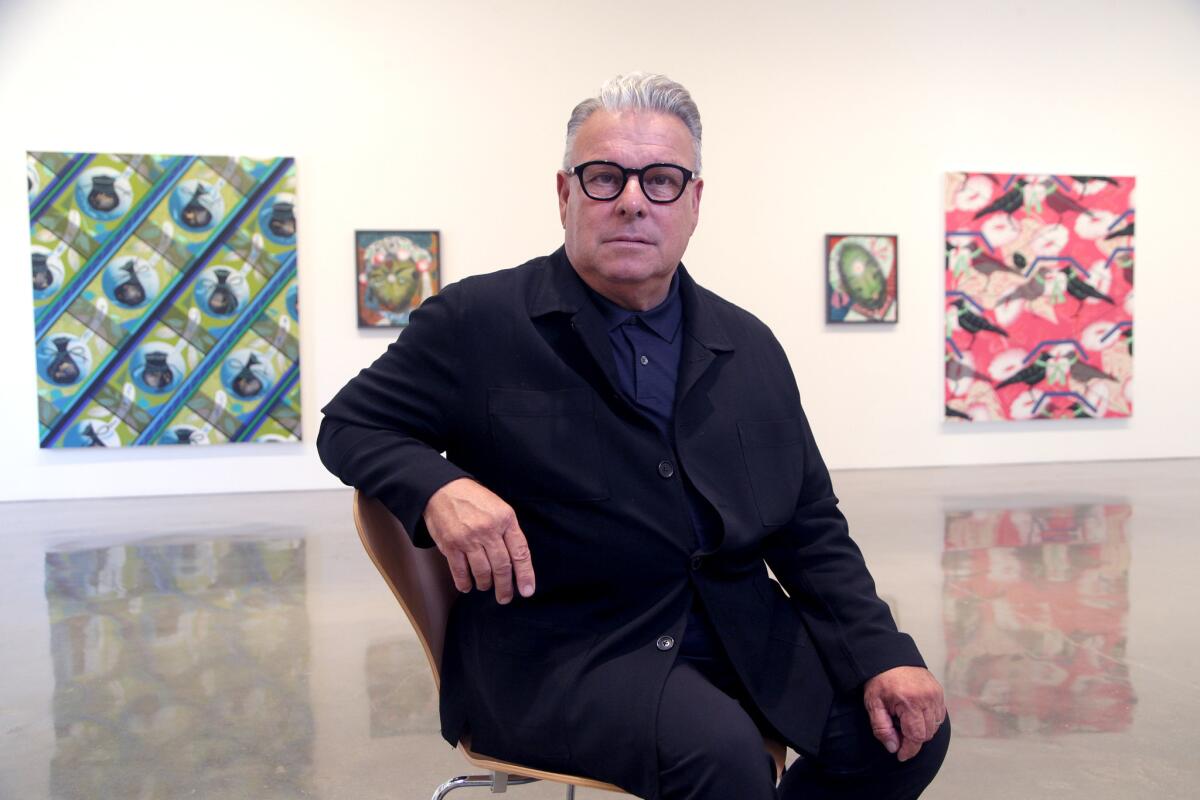Love, sex, death and the language of painting: Lari Pittman on his Hammer retrospective

- Share via
When Lari Pittman starts a painting, he doesn’t begin with a sketch. Or a canvas. He begins with words. Their sounds. Their meanings. Their inferred meanings. The complex cultural riddles an arrangement of words can evoke, the double entendres that can make a single word seem both clinical or risqué.
“I title everything first,” he says, seated in the middle of the tidy studio in Atwater Village that he shares with fellow painter and husband Roy Dowell, a place so composed it feels like an art gallery. “I’m working on a show for [the New York gallery] Lehmann Maupin, right now — slowly putting together a body of work,” he adds. “The title of the show is ‘Found Buried.’ Imagine: ‘Found Buried Off the Coast of Paris.’ ”
He lets the impossibility of the words linger. What fantastical thing could be found buried along this nonexistent coast?
In addition to the show in New York, Pittman is on this scorching Tuesday afternoon busily prepping a solo show that will open at the Hammer Museum later this month. It will be the most comprehensive career retrospective to date for this prolific Los Angeles painter, whose deeply layered canvases have tackled epic themes such as sexuality, colonialism and AIDS.
The museum’s curators had created visualizations of the installation using rendering software, to be viewed on a computer. But Pittman chooses to study the sequencing of his show on a scale model he built in his studio. “I need to be able to see things in three dimensions,” he says.

He points at the model, specifically at a miniature wall bearing sets of 70 drawings that together make up the 2014 installation “Curiosities From a Late Western Impaerium.” The installation — which will be shown in its entirety for the first time — is inspired by a variety of themes: “Needlepoint with anti-depressants.” “Stained glass for an underground bunker.” “Manifestos that fail.”
In the 14th century, if you had donned a striped shirt and walked the lanes of a medieval French town, chances are you might have been assaulted or even put to death.
“Don’t they all ultimately fail?” Pittman says wryly.
“The language prompts the imagery,” he adds. “I’ve never separated language from visual culture.”
For the artist, that language is drawn from overlapping worlds. Pittman, the son of a Colombian mother and a U.S. father, is fluent in Spanish and English and can switch between the two languages with ease. His ornate canvases, likewise, contain a fluidity of imagery and painting technique. Traditional oil paint occupies the same plane as spray-paint stenciling. Expressionistic flowers exist amid fields of color inspired by vintage textiles or contemporary graphic design. He renders bodies that are not quite bodies, but amalgamated fragments of parts that together subvert the binary of gender. A meticulously drawn turd — Pittman knows how to make poop look exquisite — is seen emerging from an abstracted pink sphincter.
In this world, the gay and the straight, the past and the present, the bitter and the sweet always co-exist.
“Lari comes from this transcultural position,” says Hammer chief curator Connie Butler, who is organizing the retrospective. “It hasn’t really been talked about in the literature of his work — the complexity of his life, living in and thinking about different cultures.”
Pittman is enthralled by that in-between state, of being able to ponder what makes language unique.
“The thing about Spanish is the diminutive — English doesn’t have it,” he says. “You’re with a friend and you say, ‘Un cafecito?’ It’s a form of consensual infantilization and intimacy. That’s something that Spanish has that is so beautiful. It’s interesting that the diminutive would make it lesser, but you’re actually elevating it. It’s not a café. It’s a cafecito.”
“That’s a complex negotiation that doesn’t exist in Anglo Saxonia,” he adds with a laugh.
Pittman’s singular view of the world, and with it, his singular artistic production, can be traced, in part, to an exceptional childhood.
The career retrospective of the L.A. painter is nothing short of smashing. Why Lari Pittman’s densely layered brand of visual overload yields profound meaning.
His father was born in Arkansas. His mother hailed from Tumaco, a small town that straddles the Colombian mainland and a couple of diminutive islands near the Ecuadorean border. The couple met in Colombia, where Pittman’s father worked for an international lumber concern. Pittman was born in the U.S. — in 1952, at Glendale Memorial Hospital — but he spent a half dozen years of his childhood living in Colombia, first in Cali, then in Tumaco.
His early education was improvised: With few options available in Tumaco, his father joined with a couple of other lumber company employees to pay for a tutor for their children.
“Our teacher was Profesor Vicente Benavides, who was a painter — religious — and art class was a really good part of what we did,” he recalls. “We were feral. We did great walkabouts on the beach. My fondest memory is that we had to maintain our own plot of garden. One time we harvested potatoes and boiled them and ate them for lunch. I think that’s how I learned to be an independent thinker.”

Those years were formative.
“I don’t have the same acumen in Spanish that I do in English,” he says, “but my emotional registers as a human being are so located in the framework of space and time of my Latino upbringing.”
And that is something that has found its way into his work.
In Spanish, “the daily conversational language can accommodate metaphor, exaggeration, hyperbole — without it seeming disingenuous,” Pittman says. “It’s a way of perfuming the narrative.”
His canvases reflect this: collaged riots of color and imagery are rendered with Churrigueresque levels of detail.
Pittman’s 1994 work, “Untitled #30 (A Decorated Chronology of Insistence and Resignation),” for example, which is featured in the retrospective, reads like a giddy, high-art explosion. From a vehicle at the painting’s center emerge flat cartoon heads donning capotain or conical pilgrim hats. Acrobat figures decked out in fancy Victorian footwear float all over picture. The branches of a painstakingly rendered pomegranate tree, planted in the lower left corner, reach into the center of the canvas, while a manicured hand, covered in glittering diamonds, descends from the sky. Here and there, bits of signage trumpet catcalls such as “Hey Girl, Love-Sexi!” as well as a double entendre referring to ejaculation.
Painted at the height of the AIDS crisis, it is a sickly sweet deconstruction of a society in moral decay.
“I think in my work there is hyperbole and exaggeration,” says Pittman. “The over-theatricality of the work, the hyperbolic nature of the work, that comes from how language shapes the interior world.”
Ironically, Pittman’s first attempt at an arts education ended in frustration. In 1970, he enrolled at UCLA, but quickly grew disenchanted with the program.
“A professor said, ‘Lari, your work is too faggy, your work is too feminine,’” he recalls “It was not sitting well. I was not out of the closet yet.”
Painter Lee Mullican, who was then teaching at the school, recommended that Pittman give CalArts a try; the experimental art school had recently relocated to a new campus in Valencia. So in 1972, he made the transfer. And it was there that he found his métier — nurtured, in part, by the school’s rising feminist art program. Though Pittman wasn’t enrolled in that program (which then accepted only women), he was nonetheless shaped by it, since one of its founders, painter Miriam Schapiro, served as his mentor.
It was at CalArts where he ultimately came out and where he met and got together with Dowell.
“It was more queer, female and more diverse,” he says of CalArts. “As a coming-of-age homosexual, I thought, ‘Wow, this is the point of entry!’ Plus, the feminist program really embraced painting.”

Pittman was interested in the ritual of painting: the stretching of canvas, the application of gesso, the layering of paint. He was also interested in a form that was being abandoned by the mainstream art world at the time. (The ‘70s was one of many moments in art history in which painting had been declared dead.)
“I like things that are overripe, worn-out, nearly dead,” he says. “It’s not about redemption or rescue — that’s too Christian for me. It’s really about ... can we look at this degraded signification in a new way?”
In his attraction to imagery past its expiration date, Pittman has recycled fragments of old wallpapers as painterly backdrop. (For a time, in the ‘80s, he worked as a salesperson in the interior design boutique of Angelo Donghia, which served as a source of material.) He has transformed trite expressionistic landscapes into mordant meditations on life and death both on canvas and dried gourds — which for a time, in the ‘80s, he also used as canvas. He has used elaborate fonts that evoke a proclamation on parchment, but which in his hands disintegrate into the sardonic. And he has deployed 19th century-style silhouettes in abject and sexualized ways (in the decade before Kara Walker was doing the same).
“That is one of the most interesting things about his work,” says Butler. “His interest in the used-up and the overlooked and the ugly. His color choices, in past bodies of work, they are based on colors he finds really distasteful or out of fashion or kitschy or decorative and not of interest to most viewers. He likes going for that jugular and finding a way to reanimate his choice.”
On the surface, a Pittman painting might seem to conjure effete mannerism. Look closer and you will find unbridled desire, wicked humor and rage.
It is a rage that he has frequently directed at heedless violence — the violence of colonial conquest, a history that the U.S. and Colombia both share, or the violence of a U.S. government willfully abandoning gay men to their fates during the AIDS epidemic (when Pittman lost friends and acquaintances). And, of course, there is gun violence, which the artist has experienced directly: he survived being shot in the stomach during a home invasion in Los Angeles in 1985.
In an era of frequent mass shootings, “I always think of the people who survive,” says the artist. “If you are shot in the stomach, they almost invariably give you a colostomy, which I had — though I was lucky to have it reversed. That is a mess. So, think of that collateral, endlessly giving damage if you’re shot.”
The episode has come back to haunt him. About half a dozen years ago he required emergency surgery while on vacation in Mexico — a side effect of the shooting. But he nonetheless prefers to keep his gaze forward. “My feeling is if you patch me up, point me in a direction,” he exclaims, “I’m talking and living!”
Preparation for the retrospective, however, has had him looking back. His paintings have broadly captured currents in history and currents in his own life. He says he is not a political painter, though politics appear in his work.
“I like depicting and decorating the collateral damage, not the root cause,” he says. “Hopefully, in retrospect, it’s a view of America.”
"Lari Pittman: Declaration of Independence"
More to Read
The biggest entertainment stories
Get our big stories about Hollywood, film, television, music, arts, culture and more right in your inbox as soon as they publish.
You may occasionally receive promotional content from the Los Angeles Times.












